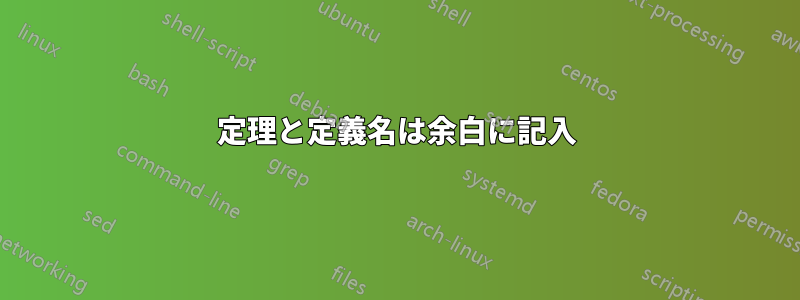
答え1
環境を間接的に定義できますtheorem。
\documentclass{article}
\usepackage{amsthm,marginnote,xparse}
\newtheorem{theoreminner}{Theorem}
\NewDocumentEnvironment{theorem}{o}
{\theoreminner\IfValueT{#1}{\marginnote{\normalfont\footnotesize#1}}}
{\endtheoreminner}
\reversemarginpar
\begin{document}
\begin{theorem}
This theorem has no attribution.
\end{theorem}
\begin{theorem}[theorem name]
This theorem has a name.
\end{theorem}
\end{document}
答え2
あなたの質問にはいくつか重要な詳細が欠けており、特に「定理のような」環境を定義するために特定のパッケージを使用しているかどうかが指定されていません。 を使用していると仮定しますamsthm。
次のソリューションは、コマンドamsthmの の定義を直接ハックし\@begintheorem、あらゆる種類の「定理のような」環境 (命題、補題、定義など) に自動的に適用されます。これは\marginpar、LaTeX カーネルの コマンドの使用に基づいています。このコマンドは「外部段落モード」で発行する必要があるため、状況が少し複雑になります。実際、元のコマンドに基づくソリューションが可能であることを示す目的でコードを作成しました\marginpar。
% My standard header for TeX.SX answers:
\documentclass[a4paper]{article} % To avoid confusion, let us explicitly
% declare the paper format.
\usepackage[T1]{fontenc} % Not always necessary, but recommended.
% End of standard header. What follows pertains to the problem at hand.
% \usepackage{amsmath} % not essential, but you probably want it too
\usepackage{amsthm}
\usepackage{etoolbox} % for "\patchcmd"/"\pretocmd"
%%%%%%%% BEGIN WIZARDRY %%%%%%%%
\makeatletter
\wlog{****************************************}
\patchcmd{\@begintheorem}{% search for:
\@ifempty{#3}{\let\thmnote\@gobble}{\let\thmnote\@iden}%
\thm@swap\swappedhead\thmhead{#1}{#2}{#3}%
}{% replace with:
\let\thmnote\@gobble
\thm@swap\swappedhead\thmhead{#1}{#2}{}%
}{% execute if succeeded:
\wlog{>>> 1st patch succeeded.}
}{% execute if failed:
\wlog{>>> 1st patch FAILED!}
}
\pretocmd{\@begintheorem}{% prepended code:
\@ifnotempty{#3}{\def\@thm@marginal@note@text{#3}}%
}{% execute if succeeded:
\wlog{>>> 2nd patch succeeded.}
}{% execute if failed:
\wlog{>>> 2nd patch FAILED!}
}
\wlog{****************************************}
\newcommand*\@thm@marginal@note@text{}
\newcommand*\@thm@marginal@note@helper{%
\begingroup \setbox\z@ \lastbox \endgroup
\marginnote{\@thm@marginal@note@text}%
}
\dth@everypar = \expandafter {%
\expandafter \@thm@marginal@note@helper
\the \dth@everypar
}
\makeatother
%%%%%%%% END WIZARDRY %%%%%%%%
\newcommand*{\marginnote}[1]{%
\marginpar
[\footnotesize\raggedleft #1]%
{\footnotesize\raggedright #1}%
}
\reversemarginpar % ?
\newtheorem{theorem}{Theorem}
\newtheorem{lemma} {Lemma}
\theoremstyle{definition}
\newtheorem{defin}{Definition}
\begin{document}
This text comes before the first definition.
\begin{defin}[Important definition]
A definition is \textbf{important} if and only if it is not
unimportant.
\end{defin}
And, of course:
\begin{defin}
An \textbf{unimportant} definition is one that is not important.
\end{defin}
Now a theorem:
\begin{theorem}[Important Theorem]
All theorems are important, but some theorems are more important
than others.
\end{theorem}
The proof rests on the following
\begin{lemma}[Important lemma]
Not all theorems (or lemmas) are equally important.
\end{lemma}
An unimportant theorem:
\begin{theorem}
Blah blah blah\ldots
\end{theorem}
And an unimportant lemma:
\begin{lemma}
Blah blah blah\ldots
\end{lemma}
Here is a little more text.
\end{document}
昔ながらの「ビンテージ」コードとその使用法に注目してください\expandafter… ;-)
出力:





